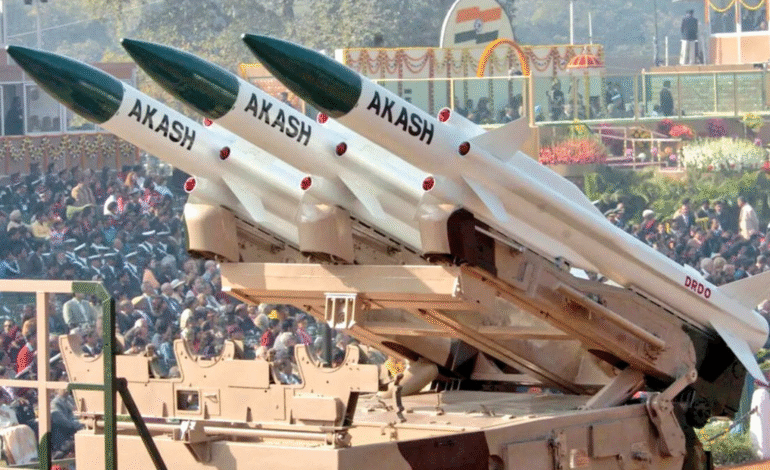India Strengthens Defence With Akash Prime and Akash-NG Missiles

India continues to push the boundaries of its missile defence technology with the Akash Prime and Akash-NG, the two latest variants of the country’s acclaimed surface-to-air missile (SAM) systems. Developed by the Defence Research and Development Organisation (DRDO), these advanced missile systems represent India’s effort to secure its airspace and respond effectively to both conventional and non-conventional aerial threats. The conversation surrounding these two systems has intensified recently after successful trials and performance validations, particularly in high-altitude and low-temperature zones.
What Is Akash Prime and Why Is It Important?
Akash Prime is the latest enhancement in the Akash family of air defence systems. Designed to serve in extreme terrain conditions, it is tailored for deployment in high-altitude regions and freezing environments like Ladakh and the Siachen Glacier. This variant has been developed to counter fast-moving aerial threats such as unmanned aerial vehicles (UAVs), cruise missiles, and combat aircraft.
A defining feature of Akash Prime is its indigenously developed active Radio Frequency (RF) seeker. This technology makes it possible for the missile to more accurately track and eliminate manoeuvring targets. The incorporation of thermal shielding and environmental resistance features ensures that the missile maintains performance even under intense stress from snow, altitude, and wind conditions. With a striking range of around 30 kilometres and an engagement altitude of up to 18 kilometres, Akash Prime fills a unique operational gap for the Indian Armed Forces.
Legacy of Akash: The Evolution of India’s Missile Defence
To fully appreciate the significance of Akash Prime, it is essential to understand the legacy of the Akash missile defence program. The original Akash Mk-1 missile was introduced to the Indian Air Force and Army as a medium-range surface-to-air missile capable of defending strategic installations. This was followed by the improved Akash-1S, which came with an electro-optical proximity fuse and enhanced engagement accuracy.
The next leap was the Akash New Generation (Akash-NG), which became a technological pivot point in India’s missile narrative. Akash NG offered longer range, higher mobility, faster reaction times, and a more modern launch platform. Now, with Akash Prime, India is looking at rugged terrain capabilities where traditional SAM systems might underperform.
Akash Prime’s Unique Role in Mountain Warfare
Unlike other surface-to-air missiles that may falter under sub-zero conditions, Akash Prime has been specifically designed for mountainous warfare. The system is especially vital in border regions such as Arunachal Pradesh and Ladakh, where weather changes rapidly and enemies can exploit aerial mobility. Akash Prime’s rugged build and upgraded radar system allow it to operate effectively even when traditional surveillance and missile guidance might face difficulty due to terrain distortion or temperature shifts.
It also plays a psychological role showcasing India’s commitment to defending even the most difficult-to-access regions with cutting-edge technology.
Understanding the Akash Missile Defence System in Detail
The Akash missile system is not just a missile it is a complete ecosystem designed for battlefield dominance. A single battery usually consists of a powerful radar system, command and control vehicles, and four launchers. Each launcher is capable of carrying three ready-to-fire missiles. The system as a whole can track up to 64 targets simultaneously and engage 12 of them in real-time.
The high-explosive warhead weighs approximately 60 kilograms and is designed to destroy airborne threats with pinpoint accuracy. The missile travels at supersonic speeds and uses command guidance from the ground station, updated continuously through secure digital links. With a coverage of up to 2,000 square kilometres, the system is capable of defending a large zone including troop concentrations, airbases, and communication centres.
Akash-NG: India’s Next-Generation Missile Technology
While Akash Prime is optimised for environmental extremes, Akash-NG is the true evolution in terms of technology and deployment efficiency. This New Generation variant extends its operational range to 70–80 kilometres, offering a vast improvement over the previous Akash models. It uses a dual-pulse solid rocket motor instead of the older ramjet propulsion system, ensuring higher speed, smoother acceleration, and greater range consistency.
Akash-NG has been designed with mobility in mind. It features a more compact and agile ground support system, which makes it ideal for rapid deployment in changing combat environments. The improved guidance and radar systems make it more effective in neutralising low radar cross-section threats such as stealth fighters and cruise missiles.
With enhanced kill probability and quicker reaction time, Akash-NG is expected to be deployed more widely across the Indian Air Force’s strategic locations in the coming years.
Comparative Analysis: Akash Prime vs Akash-NG
Both Akash Prime and Akash-NG offer unique operational advantages, and their deployment depends on terrain, threat type, and strategic intent. Akash-NG is meant for broad operational zones and offers better range, mobility, and multi-target engagement. It serves as the future backbone of India’s layered air defence system, especially for countering stealth aircraft and long-range incursions.
Akash Prime, on the other hand, is tailor-made for specific and critical terrains. Its enhanced environmental tolerance and ruggedness make it more reliable in places where performance failure can be fatal. In essence, while Akash-NG is a strategic weapon for nationwide coverage, Akash Prime is a tactical tool focused on specialised regional dominance.
DRDO and India’s Indigenous Missile Ecosystem
The development of both Akash Prime and Akash-NG is a result of DRDO’s consistent efforts to make India self-reliant in defence manufacturing. These systems have been jointly produced by public sector undertakings like Bharat Dynamics Limited (BDL) and Bharat Electronics Limited (BEL), reflecting successful collaboration between defence research, manufacturing, and government support.
This aligns with India’s “Atmanirbhar Bharat” (self-reliant India) initiative and highlights the country’s determination to reduce dependency on imported weapon systems. It also opens the doors to international defence exports, especially to nations in Africa, Southeast Asia, and the Middle East.
Why the Middle East and UAE Are Watching Closely
India’s missile progress has not gone unnoticed by defence observers and strategic planners in the Middle East, particularly the UAE. The UAE has collaborated with India on several defence research initiatives and has shown growing interest in India’s military technology. With escalating threats in the Gulf region, countries like the UAE are actively exploring advanced air defence options.
Akash Prime’s performance in high-altitude conditions could provide a model for desert and mountain warfare environments found in parts of the Middle East. Meanwhile, Akash-NG’s long-range capability could fit into a regional defence strategy involving integrated air command networks.
With increasing geopolitical challenges, the India-UAE defence relationship may deepen, particularly through technology transfers, co-development agreements, and training collaborations involving such missile systems.
Strategic Implications and the Future of Indian Air Defence
The combined deployment of Akash Prime and Akash-NG gives India flexibility, resilience, and layered coverage for its airspace. These systems act as force multipliers, particularly in times of crisis when every second counts.
As the Indian military continues to modernise, the focus is shifting toward network-centric warfare, where systems like Akash are not isolated units but integral components of a broader, interconnected defence architecture. With threats now evolving to include drone swarms, hypersonic glide vehicles, and AI-guided projectiles, missile defence systems need to be smarter, faster, and more responsive.
Akash Prime and Akash-NG represent that new mindset blending old-school ruggedness with next-gen precision.
India’s Missile Strategy Grows Stronger
India’s Akash missile programme has matured into one of the most reliable and versatile air defence systems in Asia. The latest additions, Akash Prime and Akash-NG, strengthen this legacy. One focuses on surviving and dominating hostile environments, while the other expands the horizon for strategic air coverage.
Together, they not only safeguard the Indian sky but also signal to the world especially partners in the Middle East that India is ready to lead the future of indigenous, reliable, and export-worthy defence technology.
As trials continue and deployment scales up, the Akash missile family could soon become a benchmark for medium-range SAM systems globally.







